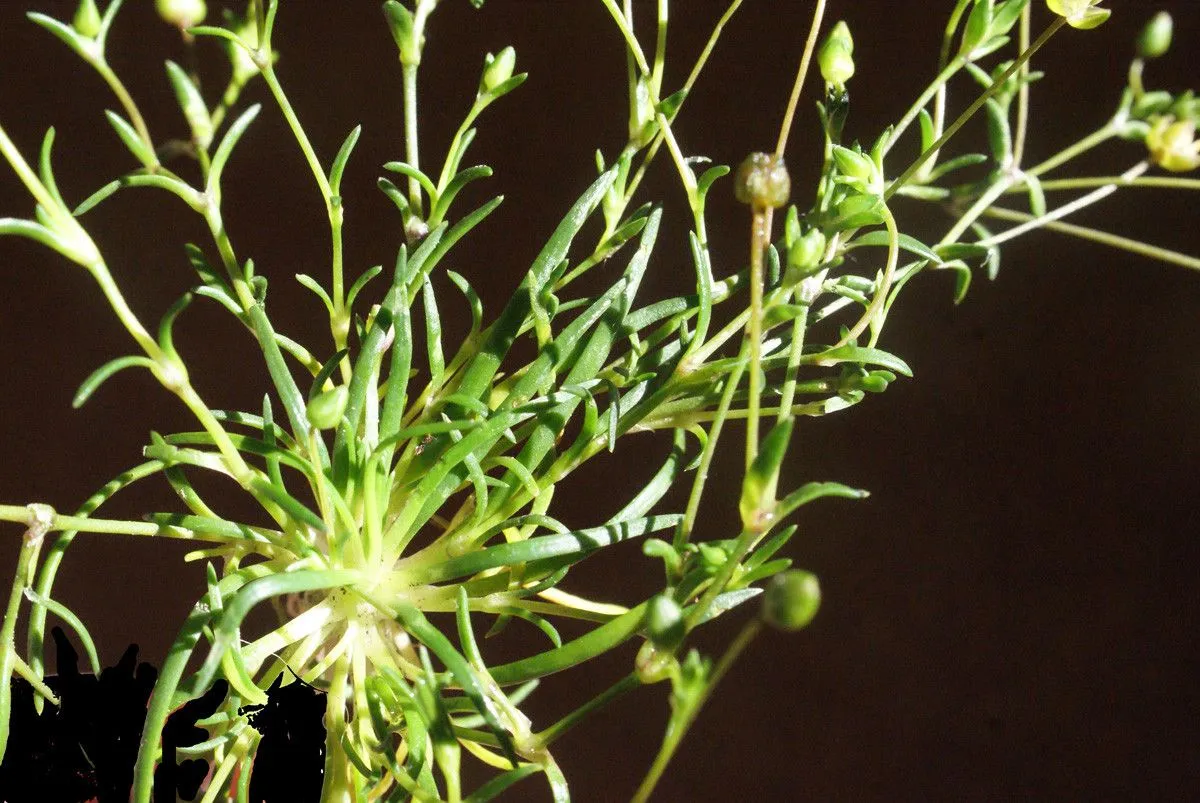
Author: Ard.
Bibliography: Animadv. Bot. Spec. Alt. 2: xxii (1764)
Year: 1764
Status: accepted
Rank: species
Genus: Sagina
Vegetable: False
Observations: Europe to N. Pakistan, Macaronesia, N. Africa to Ethiopia
Annual pearlwort, scientifically known as Sagina apetala, is a charming member of the Caryophyllaceae family. This delicate, herbaceous plant has carved out a niche for itself across a broad geographic range, flourishing from Europe through Northern Pakistan, extending its presence into Macaronesia, and even spreading as far as North Africa to Ethiopia.
First recorded in 1764 within the botanical literature “Animadversiones Botanicae Specimen Alterum,” Sagina apetala has intrigued botanists for centuries. Its allure lies not only in its subtle beauty but also in its adaptability to various climates and terrains, making it a versatile specimen for study and observation.
The Annual pearlwort is recognized for its petite, yet resilient nature, typically thriving in well-drained, sandy soils. This hardy plant is often found in meadows, grasslands, and even sparsely vegetated rocky areas, where it forms low, dense mats of foliage. The plant’s foliage is characterized by small, needle-like leaves that are lush green, adding a delicate touch to its environment.
Despite its unassuming size, Sagina apetala plays a vital role in its ecosystems. It serves as ground cover, preventing soil erosion and providing a habitat for various small insects. Its presence is a testament to the intricate balance of flora in these regions, contributing to biodiversity and ecological stability.
The flowers of the Annual pearlwort are particularly intriguing. True to its name, the plant produces tiny, apetalous blossoms—meaning they lack petals—rendering them almost inconspicuous at a glance. However, a closer inspection reveals the delicate structure of these flowers, with their subtle greenish hues blending harmoniously with the foliage.
As a species that has adapted to a wide range of environments, Sagina apetala offers a range of interests for botanists, ecologists, and garden enthusiasts alike. Its resilience and subtle beauty make it a plant worth observing and preserving. Whether studied for academic purposes or admired in a natural landscape, the Annual pearlwort is indeed a botanical treasure, echoing the grandeur of nature’s diversity in its modest appearance.
Eng: annual pearlwort, common pearlwort, small-flowered pearlwort
Deu: kronblattloses mastkraut, wimper-mastkraut
Dan: kronløs firling, mark-firling
Nld: donkere vetmuur en uitstaande vetmuur, donkere vetmuur
Fra: sagine apétale
Swe: fältnarv
Nob: trådsmåarve
Nno: trådsmåarve
Cym: corwlyddyn anaf-flodeuog, corwlyddyn blynyddol, corwlyddyn diarlenog, corwlyddyn unflwydd
En: Annual pearlwort, Common pearlwort, Small-flowered pearlwort, Small-flower Pearlwort
Ca: Sagina apètala
Cs: Úrazník brvitý
Da: Kronløs firling, Mark-firling
Nl: Tengere vetmuur, Donkere vetmuur, Donkere vetmuur en uitstaande vetmuur
Fi: Ketohaarikko
Fr: Sagine apétale, Sagine sans pétales, Sabline à deux fleurs, Sabline biflore
De: Kronblattloses Mastkraut, Wimper-Mastkraut, Bewimpertes Mastkraut, Kronenloses Mastkraut
He: סגינה זעירה
It: Sagina senza petali
Nb: Trådsmåarve
Nn: Trådsmåarve
Fa: صدفیسای یکساله
Pl: Karmnik bezpłatkowy
Es: Sagina apetala
Sv: Fältnarv
Uk: Моховинка безпелюсткова
Cy: Corwlyddyn unflwydd, Corwlyddyn Anaf-Flodeuog, Corwlyddyn Blynyddol, Corwlyddyn Diarlenog
Taken Apr 27, 2022 by Noya Jordi (cc-by-sa)
Taken Apr 27, 2022 by Noya Jordi (cc-by-sa)
Taken Apr 27, 2022 by Noya Jordi (cc-by-sa)
Taken Jun 17, 2019 by slipperwoman (cc-by-sa)
Taken Jun 11, 2022 by Vanessa Sculac (cc-by-sa)
© copyright of the Board of Trustees of the Royal Botanic Gardens, Kew.
© copyright of the Board of Trustees of the Royal Botanic Gardens, Kew.
© copyright of the Board of Trustees of the Royal Botanic Gardens, Kew.
Taken Oct 10, 2014 by Tela Botanica − Liliane Roubaudi (cc-by-sa)
Taken Oct 10, 2014 by Tela Botanica − Liliane Roubaudi (cc-by-sa)
Taken Oct 10, 2014 by Tela Botanica − Liliane Roubaudi (cc-by-sa)
Taken Oct 10, 2014 by Tela Botanica − Liliane Roubaudi (cc-by-sa)
Taken Jun 19, 2015 by Tela Botanica − Jean-Jacques HOUDRÉ (cc-by-sa)
Taken Jun 13, 2019 by Valérie Muyard (cc-by-sa)
Taken Jun 13, 2019 by Christian Pradier (cc-by-sa)
Taken Aug 20, 2021 by Bart Smet (cc-by-sa)
Taken Apr 12, 2021 by Aurélia et JChris Courte-Barbary (cc-by-sa)
Taken Apr 12, 2021 by Aurélia et JChris Courte-Barbary (cc-by-sa)
Taken Jun 4, 2013 by Martin Bishop (cc-by-sa)
Taken Nov 30, 2014 by EOL − Colin Meurk (cc-by)
Taken Jan 1, 1900 by EOL − Encyclopedia of Life (cc-by-nc)
Taken May 19, 2013 by Tela Botanica − Liliane Roubaudi (cc-by-sa)
Taken May 19, 2013 by Tela Botanica − Liliane Roubaudi (cc-by-sa)
Taken Aug 15, 2007 by Photoflora – Benoit BOCK (©)
Taken Mar 17, 2015 by Tela Botanica − Renate Trübenecker (cc-by-sa)
Taken Oct 10, 2014 by Tela Botanica − Liliane Roubaudi (cc-by-sa)
Taken Jun 19, 2021 by Sans Attaches (cc-by-sa)
Taken Jun 19, 2021 by Sans Attaches (cc-by-sa)
Taken Feb 14, 2021 by alain croibien (cc-by-sa)
Taken May 2, 2019 by Jean Burger (cc-by-sa)
Taken May 15, 2007 by Photoflora – Jean-Luc TASSET (©)
Growth habit: Forb/herb
Ph maximum: 5.5
Ph minimum: 5.0
Light: 7
Atmospheric humidity: 4
Soil nutriments: 5
Family: Myrtaceae Author: (F.Muell.) K.D.Hill & L.A.S.Johnson Bibliography: Telopea 6: 402 (1995) Year: 1995 Status:…
Family: Rubiaceae Author: Pierre ex A.Froehner Bibliography: Notizbl. Bot. Gart. Berlin-Dahlem 1: 237 (1897) Year:…
Family: Sapindaceae Author: Koidz. Bibliography: J. Coll. Sci. Imp. Univ. Tokyo 32(1): 38 (1911) Year:…
Family: Asteraceae Author: A.Gray Bibliography: Pacif. Railr. Rep.: 107 (1857) Year: 1857 Status: accepted Rank:…
Family: Fabaceae Author: Medik. Bibliography: Vorles. Churpfälz. Phys.-Ökon. Ges. 2: 398 (1787) Year: 1787 Status:…
Family: Aspleniaceae Author: (Cav.) Alston Bibliography: Bull. Misc. Inform. Kew 1932: 309 (1932) Year: 1932…